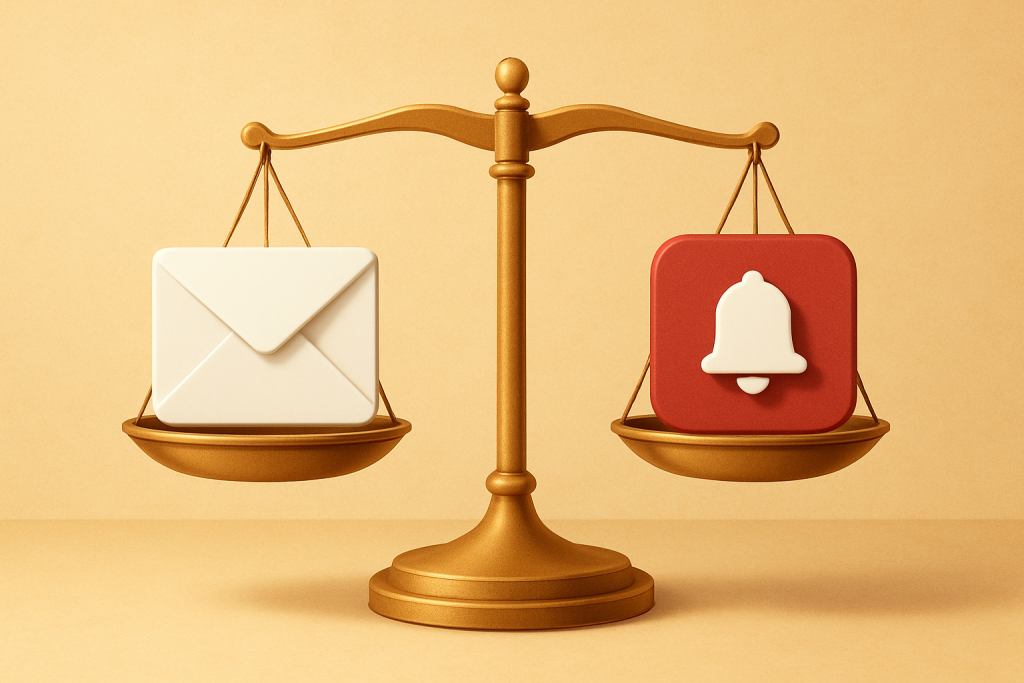In the fast-paced world of e-commerce, capturing and retaining customers is paramount. Two powerful tools frequently employed are email marketing and push notifications. But which reigns supreme? The truth is, it’s not an either/or situation. This article delves into the strengths and weaknesses of each channel, helping you determine the best strategy—or combination of strategies—for your Shopify store.
Understanding the Strengths of Each Channel
Both email marketing and push notifications serve distinct purposes in your overall marketing strategy. Understanding their individual strengths is crucial to leveraging their full potential.
Email Marketing: The Workhorse
Email marketing remains a cornerstone of digital marketing. Its strengths lie in:
- Broad Reach: Email addresses are widely available, allowing you to reach a substantial portion of your audience.
- Detailed Content: Emails allow for rich content including detailed product descriptions, high-quality images, and compelling calls to action.
- Segmentation and Personalization: Advanced email platforms enable sophisticated segmentation, allowing personalized messaging based on customer behavior, preferences, and purchase history.
- Established Infrastructure: Most businesses already have an email marketing system in place, minimizing the learning curve.
Push Notifications: The Immediate Messenger
Push notifications, on the other hand, excel in their immediacy and direct engagement:
- High Engagement Rates (when done right): Push notifications can achieve significantly higher open rates than emails, especially when used strategically for time-sensitive offers or important updates.
- Direct and Immediate Communication: They deliver messages directly to the customer’s device, bypassing the inbox clutter and providing instant updates.
- Enhanced User Experience (UX): When used judiciously, push notifications can improve the customer experience by providing relevant information at the right time, such as order updates or flash sale reminders.
- Targeted Retargeting: They are particularly effective for retargeting abandoned carts or reminding customers about items they viewed but didn’t purchase.
Comparing Open Rates and Click-Through Rates
A key metric for comparing email and push notification effectiveness is open and click-through rates. While generalizations can be misleading, push notifications typically boast significantly higher open rates than email. This is largely due to the immediate nature of the notification and the lack of competition from other messages in an inbox. However, click-through rates can vary greatly depending on the quality of the notification’s messaging and the relevance of its content to the recipient. A poorly crafted push notification will result in low click-through rates, irrespective of its high open rate.
Analyzing Reach and Segmentation Capabilities
Email marketing’s strength in segmentation is well-established. Sophisticated email marketing platforms allow for highly targeted campaigns based on demographics, purchase history, and browsing behavior. Push notifications offer a different approach to segmentation. While generally not as granular as email segmentation, push notifications excel in their ability to target users based on their real-time actions on your website or app. For instance, a user abandoning their cart triggers an immediate push notification, significantly improving the chance of recovering the sale.
Determining Cost-Effectiveness
Both email marketing and push notifications can be cost-effective, depending on your strategy and the tools you use. Email marketing platforms often involve monthly subscriptions or pay-per-send fees. Push notification services, like Pushloop, may offer various pricing tiers, often based on the number of subscribers or features used. However, the ultimate cost-effectiveness is determined by the return on investment (ROI) generated by each channel. A high open and click-through rate for push notifications could translate to a higher conversion rate and a superior ROI compared to email, even with a higher cost per notification.
Integrating Both for Maximum Impact
The ideal approach is often to integrate both email and push notifications into a cohesive strategy. Email marketing can be used for broader communications, such as newsletters, promotional campaigns, and announcements. Push notifications can then be utilized for time-sensitive updates, retargeting, and driving immediate conversions. For example, an email might announce a sale, while a push notification alerts the subscriber of a limited-time discount code.
Consider this synergistic approach: Send a welcome email series to new subscribers, establishing your brand and guiding them through your offerings. Use push notifications for immediate interactions—like abandoned cart reminders or flash sale notifications—to capitalize on the user’s current interest.
Which is Right for YOU?
There’s no single “right” answer. The best approach depends on your specific business goals, target audience, and resources. However, consider these questions:\n\n
- What is your primary objective? Brand awareness? Driving immediate sales? Increasing customer loyalty?
- What is your budget? Both email and push notification services have varying cost structures.
- What is your technical capability? Integrating push notifications requires some technical setup but is often straightforward with apps like Pushloop.
- What are your customer’s preferences? Consider how your customers engage with different communication channels.
By carefully considering these factors, you can determine the optimal blend of email and push notifications to maximize your e-commerce performance. A well-executed strategy involving both channels often yields the best results.
For Shopify merchants looking to seamlessly integrate push notifications into their marketing strategy, Pushloop offers a powerful and user-friendly solution. Its features, including abandoned cart recovery (a key benefit highlighted in its documentation: https://docs.pushloop.io/automations/how-to-set-up-an-abandoned-cart-recovery-automation/), can significantly boost your conversion rates and customer retention.

